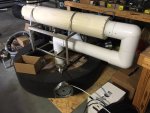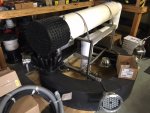To update everything...turns out these motors are rewindable submersible 30hp 460v...they run at 51A FLA 53 Max. Problem is that the system was designed for an encapsulated submersible, same size/voltage with an FLA of 40A. The 10-11A difference is creating problems with the wire, breakers, etc. I recomended that they reduce the flow by slightly closing the valve on the floating fountain. There is a ball valve but i am not sure if it is before or after the motor/pump - I am curious if that would matter. When I recomended that the response was that they tried that and it increased the amperage. Does the position of the valve matter, or should they try to create more back pressure by adjusting the nozzle?? Ultimately I want to understand how to reduce the flow therefore reducing the work/amperage.
What this is sounding like now is that the fountain was designed without a good ME who understood the complexities of pump applications. They may have picked a pump by head height, likely to get some vertical effect in the fountain, without understanding the corresponding flow and that if the pump runs open channel, as it appears to be, it is overloading the motor. If it's not being overloaded, then as I said earlier, that pump motor is either incredibly inefficient, or has a very high service factor, which from my experience with submersibles is almost never the case.
I'd also take a wild guess that when they responded that they had tried turning down the valve and the amps went up, they were fibbing. They likely didn't even try it and are afraid to, so they are saying they did in order to avoid exposing their ignorance. Not that I think you should take on that responsibility as the EC either, in fact I suggest steering clear of that. Just stick to your guns and insist that a motor rated for 40A, running at 52-53A, is going to fail in short order. The nuisance tripping is not a "problem", it's a symptom and a warning. They need to get a hydraulics expert in there to straighten this out. Not your job...
And just to warn you, a pump vendor is not the right way to go with this. I've envountered some really idiotic pump vendors in my career who have zero clue, but possess the gift of gab and convince users that they know what they are talking about. I once had one tell an end user that he could replace a 400HP pump with a 100HP pump and get the same flow rate by using a VFD. I installed the VFD and got blamed for it not working, because the VFD couldn't keep up. I pointed out that the VFD was running at 100% speed, that's when I discovered that they had yanked out a 400HP pump. When I challenged the concept, the pump vendor told me to just run the pump at 240Hz!
 [/ATTACH]
[/ATTACH]


